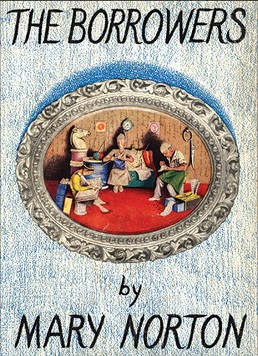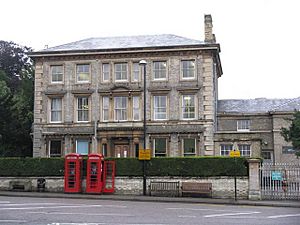The Borrowers facts for kids
|
Stanley cover of first edition
|
|
| Author | Mary Norton |
|---|---|
| Illustrator | Diana L. Stanley (first) Beth and Joe Krush (US) |
| Country | United Kingdom |
| Language | English |
| Series | The Borrowers |
| Genre | Children's fantasy novel |
| Publisher | J. M. Dent (first); Harcourt, Brace (US) |
|
Publication date
|
1952 (first) 1953 (US) |
| Media type | Print (hardcover) |
| Pages | 159pp (first); 180pp (US) |
| OCLC | 7557055 |
| LC Class | PZ7.N8248 Bd 1952 |
| Followed by | The Borrowers Afield |
The Borrowers is a popular children's fantasy novel written by the English author Mary Norton. It was first published in 1952. The story is about a secret family of tiny people. They live hidden inside the walls and under the floors of an old English house. To survive, they "borrow" small items from the "Big People" who live in the house.
The name The Borrowers also refers to a series of five books. These books follow the same tiny family on many adventures after they leave their first home. The first book won the 1952 Carnegie Medal. This award celebrates the best children's book by a British author each year. In 2007, it was even named one of the top ten books to ever win the Medal!
The book was published in the U.S. in 1953. It has also been made into several TV shows and movies.
Contents
The Borrowers Book Series
All five books in The Borrowers series are about the Clock family. This family includes Pod, Homily, and their daughter Arrietty. In the first book, they live in a house that was inspired by 'The Cedars'. This was Mary Norton's own childhood home.
The other books in the series have titles that start with the letter 'A':
- The Borrowers Afield (1955)
- The Borrowers Afloat (1959)
- The Borrowers Aloft (1961)
- The Borrowers Avenged (1982)
A big book called The Complete Borrowers Stories was published in 1983. It included all five novels.
Adventures of the Tiny Clock Family
The main excitement and problems in the stories come from the tiny Borrowers meeting "human beans." Sometimes the humans are kind, and sometimes they cause trouble. The main character is Arrietty, who is a teenager. She often starts friendships with Big People. These friendships usually lead to big changes and adventures for her and her family. Her parents often get very worried!
Because Arrietty is so curious and makes friends with humans, her family has to move their home many times. This makes their lives much more exciting than most Borrowers would like. They escape from their home under the kitchen floorboards of an old English manor. Later, they find a new home with a caretaker near an old church.
Along their journey, they meet many other characters:
- Other Borrowers: These include a young man named Dreadful Spiller. He lives outdoors and is about Arrietty's age. They also meet the Harpsichord family, who are relatives of the Clocks.
- Big People: These include Mild Eye the gypsy, Tom Goodenough the gardener's son, and Miss Menzies, a kind but sometimes too-helpful woman.
A shorter book called Poor Stainless (1966) tells an earlier story. Homily tells Arrietty about a small adventure Stainless had when he got lost. Many Borrower names, like Stainless, come from human objects, such as kitchen cutlery.
Main Characters in The Borrowers
The books feature a wonderful cast of characters, both tiny and human-sized.
The Borrowers Characters
- Arrietty Clock: She is a curious and brave fourteen-year-old Borrower. Arrietty loves to read and has a collection of tiny books. She is very interested in "human beans" after meeting The Boy. She is also smart enough to realize that Borrowers might be disappearing. Her interactions with humans often worry her parents.
- Pod Clock: Arrietty's father. He is a very skilled Borrower and a shoemaker. He makes tiny boots from beads and old gloves. Pod is careful but open to new ideas. He is also quick to invent and fix things.
- Homily Clock: Arrietty's mother. She is a bit nervous and loves her neat home. She doesn't like the idea of hardship or discomfort. But when things get tough, she often shows great strength, even if she complains a lot! She is very proud of Arrietty and encourages her to read.
- Hendreary Clock: Arrietty's uncle and Pod's brother. Many Borrower families used to live in the house, including his. But they had to leave after Hendreary was "seen" by a human. When he appears later, he is tired and lets his wife make all the important decisions.
- Lupy (Rain-Pipe Harpsichord) Clock: Uncle Hendreary's wife. Homily doesn't like Lupy much because she acts snobby. Lupy was once part of the important Harpsichord family. Lupy is bossy and likes to be in charge. She has three sons from a previous marriage and a stepdaughter, Eggletina.
- Eggletina Clock: Hendreary's daughter from his first marriage. Her family tried to protect her by not telling her about the dangers of the Big House. She didn't know that the "human beans" had a cat. Eggletina wandered out and was thought to have been eaten. But in the second book, Arrietty finds out she is still alive. She is a thin and shy girl.
- The Overmantels: A family of Borrowers who lived on the drawing room mantelpiece. They were snobby, but Homily felt sorry for them. They often went hungry because they only had breakfast food to "borrow." They moved away when there were too few humans to support them.
- The Harpsichords: Another Borrower family who lived in the drawing room. They were also a bit snobby and had good manners. They also suffered from not having enough food. They moved away when the drawing room was no longer used.
The Big People Characters
- Kate: A lively and sometimes messy ten-year-old girl. Kate learns about the Borrowers in the first book. As she gets older, she tries to find more clues about their existence.
- The Boy: A ten-year-old boy sent to his great-aunt's country home to get better after being sick. He grew up in India and finds reading in English a bit hard. He is often quiet, which the servants think means he is sneaky. He becomes friends with Arrietty and her family.
- Mrs May/Aunt May: Kate's elderly aunt. She tells Kate the story of the Borrowers. The Boy was her brother. When she was young, she heard his stories and spent a lot of time trying to find out if they were true. Later, as an adult, she inherits a cottage where more Borrowers are thought to live.
- Great-Aunt Sophy: The Boy's elderly great-aunt. She is sick and never leaves her bed. The servants and the Borrowers call her "Her." Pod sometimes visits her. She believes the Borrowers are just her imagination.
- Mrs Driver: The housekeeper and cook. Since Great-Aunt Sophy is in bed, Mrs Driver is in charge of the whole house. She is grumpy, bossy, and gossips a lot. She doesn't like having to look after The Boy.
- Crampfurl: The gardener and Mrs Driver's friend. He also dislikes The Boy, just because Mrs Driver is suspicious of him.



